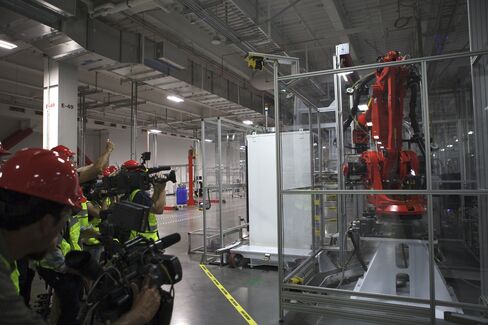Panasonic is also shipping cells from Japan to the Powerwall business, which is operating in another section of the factory. Robots are used to place battery packs into home and office units, which store energy from solar panels and allow users to tap it during peak periods. Musk said the Powerwall business will initially make up about one-third of the Gigafactory’s output, but eventually could expand to around half.
Outside, nearly 1,000 workers are laying the groundwork for the factory’s expansion, digging trenches and erecting steel supports in the hot, dusty valley. By the second quarter of 2017, 31 percent of the factory will be completed. Eventually, the roof will be covered in solar panels.
Musk noted that some of the area’s 10,000 wild horses often drink from the ponds at the construction site. Nevada won the factory thanks in part to $1.3 billion in tax incentives, which will benefit Tesla over a 20-year period.
“I find this to be quite romantic,” he said. “It feels like the wild West.”
The factory’s name stems from “giga,” a unit of measurement that represents billions. One gigawatt hour is the equivalent of generating one billion watts for one hour — one million times that of one kilowatt hour.
Tesla says the factory will be producing 35 gigawatt hours of batteries by 2018. That’s the equivalent to the entire world’s production in 2014. Tesla CEO Elon Musk has said the factory has the capacity to produce 150 gigawatt hours if it needs to. To put that in context, New York City uses around 52 gigawatt hours of energy per year.
Analysts say bringing battery production in-house, instead of buying batteries like General Motors Co. and other major automakers do, can help bring down costs, but also leaves Tesla exposed. If the Model 3 is delayed, for example, or customers’ deposits don’t turn into actual sales, Tesla will have extra batteries on its hands and no way to recoup its costs.
“They could be left with a lot of excess capacity in the near term,” said Sam Abuelsamid, an analyst with Navigant Research. Abuelsamid says there’s also the possibility that advances in battery technology in the longer term could force Tesla to make expensive new investments.
There are also competitors who could derail Tesla’s dreams. Chinese automaker BYD Co., which is backed by Warren Buffett’s Berkshire Hathaway Corp., also makes batteries and energy storage systems and is already building battery-powered buses in the U.S. The company hopes to bring low-cost electric cars to the U.S. in a few years.
Musk says there are still plenty of ways for Tesla to reduce costs, including making its factories more efficient and eventually building more battery factories in Europe, China and other regions where its cars are sold.
The company also is using a different type of battery cell in the Model 3 than it did in the Model S and Model X in an effort to reduce costs.
Tags: #mining, #smallcapstocks, $TSXV, lithium, lithium ion, Tesla Motor Cars
